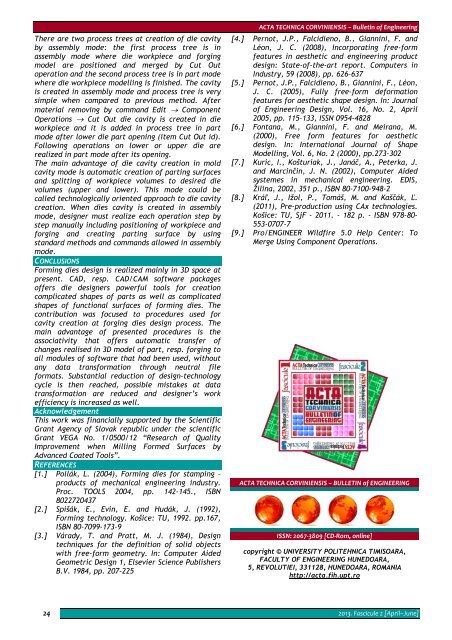a review - Acta Technica Corviniensis
a review - Acta Technica Corviniensis
a review - Acta Technica Corviniensis
You also want an ePaper? Increase the reach of your titles
YUMPU automatically turns print PDFs into web optimized ePapers that Google loves.
There are two process trees at creation of die cavity<br />
by assembly mode: the first process tree is in<br />
assembly mode where die workpiece and forging<br />
model are positioned and merged by Cut Out<br />
operation and the second process tree is in part mode<br />
where die workpiece modelling is finished. The cavity<br />
is created in assembly mode and process tree is very<br />
simple when compared to previous method. After<br />
material removing by command Edit → Component<br />
Operations → Cut Out die cavity is created in die<br />
workpiece and it is added in process tree in part<br />
mode after lower die part opening (item Cut Out id).<br />
Following operations on lower or upper die are<br />
realized in part mode after its opening.<br />
The main advantage of die cavity creation in mold<br />
cavity mode is automatic creation of parting surfaces<br />
and splitting of workpiece volumes to desired die<br />
volumes (upper and lower). This mode could be<br />
called technologically oriented approach to die cavity<br />
creation. When dies cavity is created in assembly<br />
mode, designer must realize each operation step by<br />
step manually including positioning of workpiece and<br />
forging and creating parting surface by using<br />
standard methods and commands allowed in assembly<br />
mode.<br />
CONCLUSIONS<br />
Forming dies design is realized mainly in 3D space at<br />
present. CAD, resp. CAD/CAM software packages<br />
offers die designers powerful tools for creation<br />
complicated shapes of parts as well as complicated<br />
shapes of functional surfaces of forming dies. The<br />
contribution was focused to procedures used for<br />
cavity creation at forging dies design process. The<br />
main advantage of presented procedures is the<br />
associativity that offers automatic transfer of<br />
changes realised in 3D model of part, resp. forging to<br />
all modules of software that had been used, without<br />
any data transformation through neutral file<br />
formats. Substantial reduction of design-technology<br />
cycle is then reached, possible mistakes at data<br />
transformation are reduced and designer’s work<br />
efficiency is increased as well.<br />
Acknowledgement<br />
This work was financially supported by the Scientific<br />
Grant Agency of Slovak republic under the scientific<br />
Grant VEGA No. 1/0500/12 “Research of Quality<br />
Improvement when Milling Formed Surfaces by<br />
Advanced Coated Tools”.<br />
REFERENCES<br />
[1.] Pollák, L. (2004), Forming dies for stamping –<br />
products of mechanical engineering industry.<br />
Proc. TOOLS 2004, pp. 142-145., ISBN<br />
8022720437<br />
[2.] Spišák, E., Evin, E. and Hudák, J. (1992),<br />
Forming technology. Košice: TU, 1992. pp.167,<br />
ISBN 80-7099-173-9<br />
[3.] Várady, T. and Pratt, M. J. (1984), Design<br />
techniques for the definition of solid objects<br />
with free-form geometry. In: Computer Aided<br />
Geometric Design 1, Elsevier Science Publishers<br />
B.V. 1984, pp. 207-225<br />
ACTA TECHNICA CORVINIENSIS – Bulletin of Engineering<br />
[4.] Pernot, J.P., Falcidieno, B., Giannini, F. and<br />
Léon, J. C. (2008), Incorporating free-form<br />
features in aesthetic and engineering product<br />
design: State-of-the-art report. Computers in<br />
Industry, 59 (2008), pp. 626–637<br />
[5.] Pernot, J.P., Falcidieno, B., Giannini, F., Léon,<br />
J. C. (2005), Fully free-form deformation<br />
features for aesthetic shape design. In: Journal<br />
of Engineering Design, Vol. 16, No. 2, April<br />
2005, pp. 115–133, ISSN 0954-4828<br />
[6.] Fontana, M., Giannini, F. and Meirana, M.<br />
(2000), Free form features for aesthetic<br />
design. In: International Journal of Shape<br />
Modelling, Vol. 6, No. 2 (2000), pp.273-302<br />
[7.] Kuric, I., Košturiak, J., Janáč, A., Peterka, J.<br />
and Marcinčin, J. N. (2002), Computer Aided<br />
systemes in mechanical engineering. EDIS,<br />
Žilina, 2002, 351 p., ISBN 80-7100-948-2<br />
[8.] Kráľ, J., Ižol, P., Tomáš, M. and Kaščák, Ľ.<br />
(2011), Pre-production using CAx technologies.<br />
Košice: TU, SjF - 2011. - 182 p. - ISBN 978-80-<br />
553-0707-7<br />
[9.] Pro/ENGINEER Wildfire 5.0 Help Center: To<br />
Merge Using Component Operations.<br />
ACTA TECHNICA CORVINIENSIS – BULLETIN of ENGINEERING<br />
ISSN: 2067‐3809 [CD‐Rom, online]<br />
copyright © UNIVERSITY POLITEHNICA TIMISOARA,<br />
FACULTY OF ENGINEERING HUNEDOARA,<br />
5, REVOLUTIEI, 331128, HUNEDOARA, ROMANIA<br />
http://acta.fih.upt.ro<br />
24<br />
2013. Fascicule 2 [April–June]

















